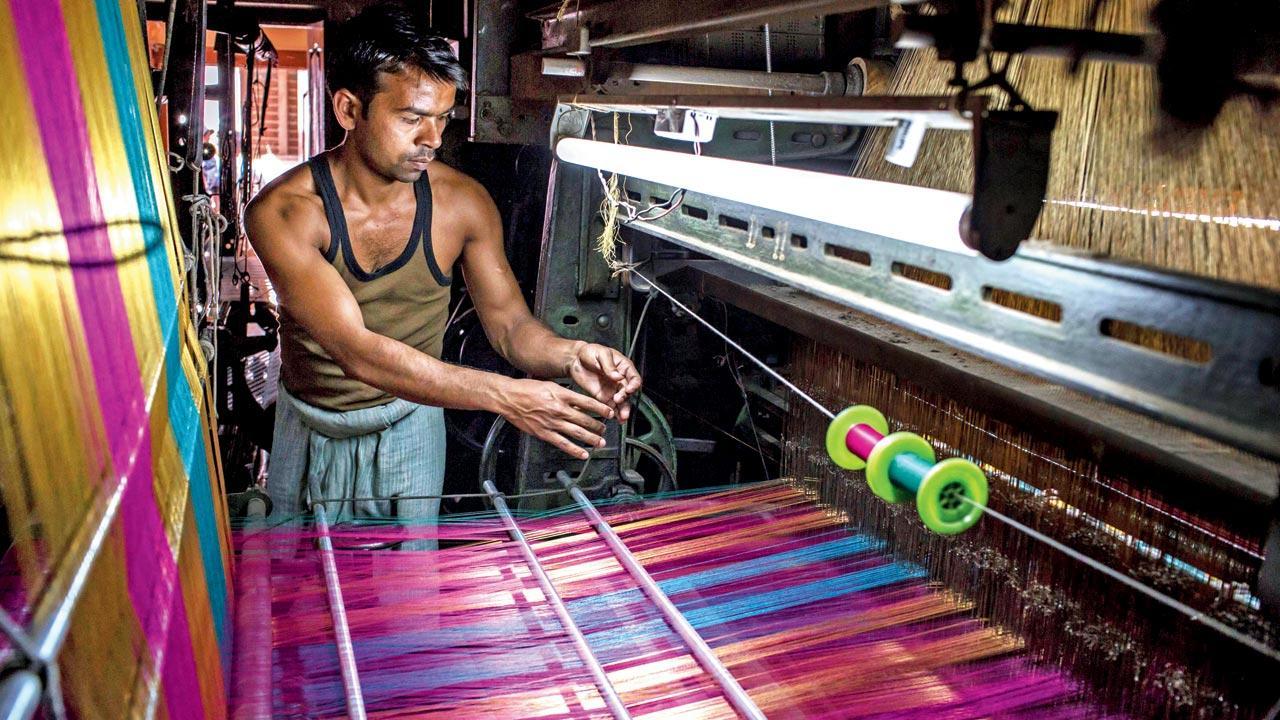Political manifestos are passe. Now, brands and designers are using fashion manifestos to address sustainable and ethical issues of India’s fashion industry.

The Dignity of the Hand manifesto recognises the skilled craft workers, like these sari weavers, whose contributions are often overlooked in today’s fast-paced world. Pic/Getty Images
Sustainability and the need for ethical fashion in India has been the talk of the town for many decades. And now, designers, stylists, and organisations are addressing these issues through manifestos, outlining their impact on the Indian and the global fashion industry. “2024 is all about a ‘narrative’. An aesthetically appealing ensemble needs to also evoke an emotion and engage in a process that develops into a conversation. All of this is only possible if a brand, organisation or a designer establishes their core values through a manifesto,” says Paras Bairoliya and Shalini Jaikaria, Director and Creative Director of Geisha Designs.
ADVERTISEMENT
Designers and stylists also believe that manifestos have the potential to bring significant change and champion diversity, by setting clear goals. “When manifestos are adopted and implemented effectively, they can influence consumer behaviour, industry practices, and even government regulations, bringing a global change to this industry,” says celebrity fashion stylist, Sheefa J Gilani.
 Sheefa J Gilani, Asmita Marwa and Dal Chodha
Sheefa J Gilani, Asmita Marwa and Dal Chodha
Inspired by the numerous fashion manifestos like the Ellen MacArthur Foundation’s Circular Fibres Initiative, El Pais’ anti-fashion article, and the G7 Fashion Pact, published globally, the Indian fashion industry in the past decade, has also taken a step towards this initiative. Designers, writers, and brands like Dal Chodha, the Fashion Revolution of India, and the League of Artisans, through their manifestos have contributed significantly to voicing a change in the country.
But despite the publication of these manifestos, industrial experts feel the need for grassroots change is most important. “Although these manifestos reflect accountability, there is also a lack of transparent reports from fashion houses, for elevating the discourse. It’s difficult to understand what profits the brands are making, what is their carbon footprint, and whether an actual change is reflected in the lives of the local artisans,” says Mourya Dandu, a fashion photographer. Hyderabad-based fashion designer Asmita Marwa also adds, “Manifestos are often just constrained to words more than actions. As a designer, I inculcated sustainability with a complete zero-waste policy, making clothes out of leftover textiles and threads. While using a method that’s best for the brand and even making luxury fashion sustainable, to reuse it over the long term, I believe ground-level changes can definitely take place.”
 Paras Bairoliya and Shalini Jaikaria, Shruti Singh, Dr. Ritu Sethi
Paras Bairoliya and Shalini Jaikaria, Shruti Singh, Dr. Ritu Sethi
Adopt cheap chic, says Dal Chodha
Quiet luxury or the limited display of personalities and wealth through clothes is an archival fashion trend that Dal Chodha, writer and editor-in-chief of Archivist Addendum (a publishing project of fashion editorial and academe), revamps through his latest manifesto, You gotta keep your head straight about clothes: An appreciation of cheap chic. It is a manifesto and appreciation of Cheap Chic, a book that was originally published in 1978, in New York, appreciating the demand for wearing second-hand clothes. “I wanted to write about something that was personal to me and explore the beauty of individual styles while defining them in the everyday,” says Chodha over a call. He also addresses how capsule closeting need not be about restricting fashion desires but about avoiding the over-consumption of clothes while appreciating and caring for every little purchase. The manifesto was written within a week or two, but it went through a rigorous process of editing and design conceptualisation. It was finally published last year with no external signatories involved. “The response of this manifesto has been amazing, making people think about their own philosophies and ideologies of how they want to present themselves through fashion,” adds Chodha. “If the industry reduces the alienation of people and imposition of their values on others, then manifestos can be a great way of bringing a change in the industry.”
Make work places healthy, says The Fashion Revolution of India
"The Fashion Revolution of India published the Manifesto for a Fashion Revolution, 10 years ago with over 16,000 signatories. Inspired by the 2012 Rana Plaza fire incident in Dhaka, this manifesto underlined the oppressive and unhealthy working culture of the industry. Similarly, Collective Fashion Justice of India, another organisation for ethical fashion, published the Total Ethics Manifesto. “The Total Ethics Fashion Manifesto aims to move the industry beyond the current definition of ‘sustainability’ in fashion, which is sterile and lifeless,” says Emma Hakansson, the founding director of Collective Fashion Justice and the author of the manifesto. “The fashion industry remains unable to truly grapple with the idea that for it to be sustainable, it must not only operate within planetary boundaries but moral boundaries, where sentient life is not exploited and taken for profit.” The manifesto has impacted audiences worldwide, highlighting the need for ethical fashion in today’s times. “The manifesto currently has 16,001 signatories, reflecting the impact it has had on experts and the audiences. Apart from its release, we have also conducted multiple events and campaigns to raise awareness about the issues that are still prevalent in the fashion industry,” says Shruti Singh, the Country Head of Fashion Revolution India.
Be vocal for the local, says League of Artisans.
The Indian fashion industry oftentimes ignores the people behind the art, especially the local artisans. With the intent of giving a voice to these artisans in India and abroad, the League of Artisans (a non-profit community interest company), published Dignity of the Hand, demanding respect and recognition for the skilled craft workers whose contributions are often overlooked in today’s world of fast fashion.“The manifesto resonated with the makers all over the world, including people in Bhutan, Argentina, Sri Lanka, and even in the United Kingdom, as it encompasses universal values that are underlined in the nine principles of the manifesto,” says Ritu Sethi, Director, League of Artisans. Although the process for the manifesto started five years back in Argentina, it was articulated after a survey of more than 500 artisans around the world. With multiple consultations and opinions from experts in the field, this manifesto aims to address and bring a change in the entire fashion ecosystem of India and abroad.
“Manifestos lets the voices of the country’s local artisans be heard, louder and clearer, drawing the attention of the policymakers and key players to bring about a significant change in the industry,” adds Sethi.
 Subscribe today by clicking the link and stay updated with the latest news!" Click here!
Subscribe today by clicking the link and stay updated with the latest news!" Click here!







